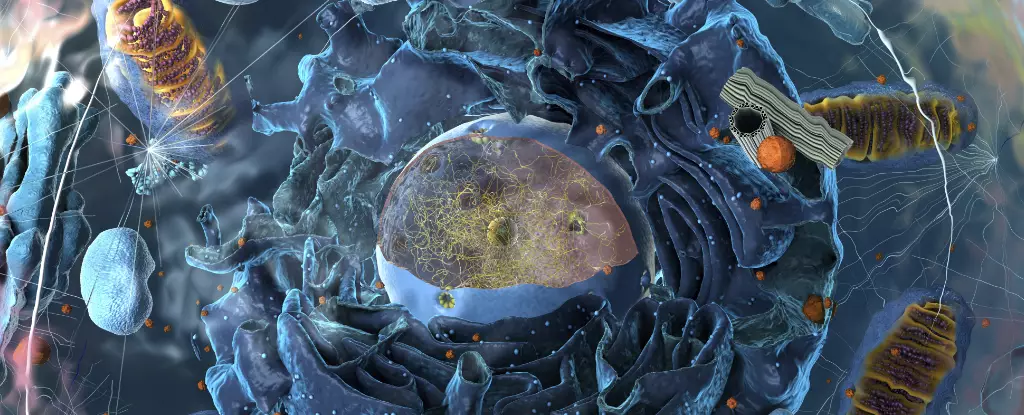In high school biology, most students are introduced to the concept of organelles, the essential components that populate cells and perform crucial functions. Membrane-bound organelles, such as the mitochondria that generate energy and the nucleus that houses genetic material, have long been the standard model for understanding cell architecture. However, this conventional view was abruptly challenged in the mid-2000s when researchers began to recognize the significance of membraneless organelles, known as biomolecular condensates. This paradigm shift opened the door to a more nuanced understanding of cellular organization and function, revealing a richer tapestry of interactions and dynamics within the cellular environment.
The concept of biomolecular condensates can be likened to a lava lamp. In a lava lamp, blobs of wax periodically merge and separate, creating unique shapes and movements. Similarly, biomolecular condensates form through the clustering of proteins and RNA molecules in a cell, leading to the creation of gel-like droplets that exhibit dynamic behavior. These condensates attract additional molecules, forming distinct biochemical compartments that facilitate various processes within the cell. Recent discoveries have identified approximately 30 different types of biomolecular condensates, significantly outpacing the known dozen or so traditional organelles. This burgeoning field raises intriguing questions about the diverse functions these non-membrane-bound structures might perform.
One of the most disruptive revelations surrounding biomolecular condensates pertains to the traditional belief that a protein’s structure dictates its function—a tenet that has guided biochemistry for decades. However, many proteins involved in forming biomolecular condensates demonstrate regions that lack a defined shape, which has led to the identification of intrinsically disordered proteins (IDPs). Initially perplexing, the roles of IDPs have been illuminated by their capacity to form condensates, suggesting that function can arise from dynamics rather than a rigid conformation. This discovery not only challenges long-standing views in protein chemistry but also expands our understanding of how cells operate at a molecular level.
A New Perspective on Prokaryotic Complexity
The discovery of biomolecular condensates has implications beyond the realm of eukaryotic cells, traditionally considered the more complex cellular forms. Researchers have now identified condensates within prokaryotic cells, which were previously characterized as lacking organelles. This finding fundamentally alters our understanding of bacterial biology, presenting them as more intricate entities than simple sacs of proteins and nucleic acids. With approximately only 6% of bacterial proteins exhibiting disordered regions compared to 30%-40% in eukaryotic proteins, the existence of biomolecular condensates suggests that even prokaryotes engage in sophisticated biochemical processes, potentially reshaping our understanding of microbial life.
Implications for the Origins of Life
The ramifications of biomolecular condensates extend even to the primordial question of what sparked life on Earth. The RNA world hypothesis posits that early life forms were primarily RNA molecules, raising questions about how these molecules could replicate and organize themselves. Traditionally, researchers have relied on the notion that membranes were essential for enclosing these early life forms. However, with the recognition that RNAs can spontaneously form biomolecular condensates, the need for lipid membranes—often difficult to synthesize under prebiotic conditions—dissipates. This could mean that life may have arisen from simpler, non-membrane-bound structures, shifting the narrative of how living systems originated from lifeless chemistry.
The Future of Biomedical Research
As scientists delve deeper into the enigmatic world of biomolecular condensates, the implications for human health and disease become increasingly pertinent. Research indicates that these structures may play a significant role in various neurodegenerative diseases, including Alzheimer’s and Huntington’s disease. This understanding has spurred the development of innovative therapeutic strategies targeting condensates, with the hope of either promoting or disrupting their formation as a means to combat disease. Although the efficacy of these approaches remains uncertain, the growing recognition of biomolecular condensates as central players in cellular dynamics positions them at the forefront of future biomedical research.
Education and the Evolving Nature of Biology
Looking ahead, the impact of biomolecular condensates on biology education cannot be understated. As our comprehension of these structures continues to evolve, future generations of biology students may find themselves facing an even more intricate picture of cellular life, filled with newly defined structures and functions. Just as previous generations learned about organelles, students will likely explore the vast complexities of biomolecular condensates, fostering an appreciation for the subtleties of life’s molecular machinery. The journey of discovery surrounding these unique organelles promises to enrich the scientific narrative, challenging both researchers and students to rethink their understanding of life at a fundamental level.

